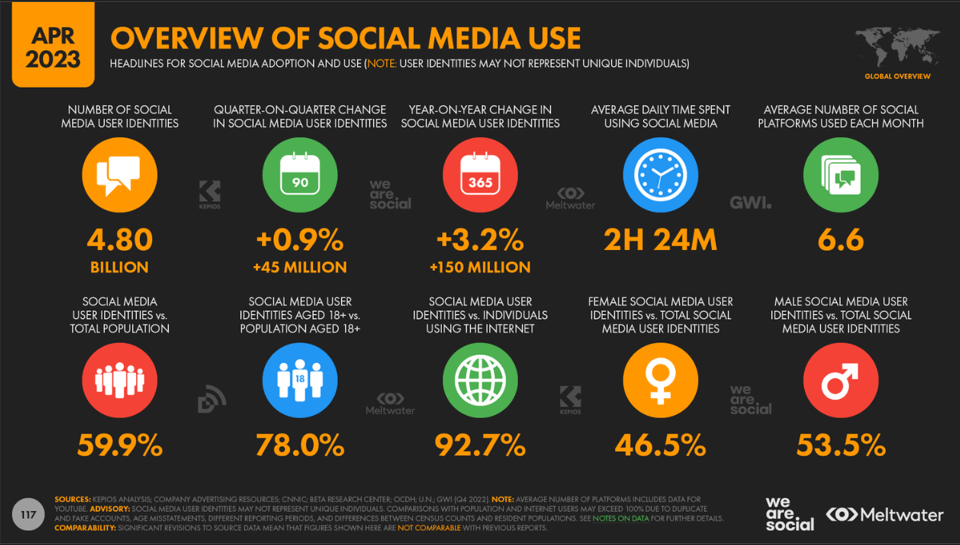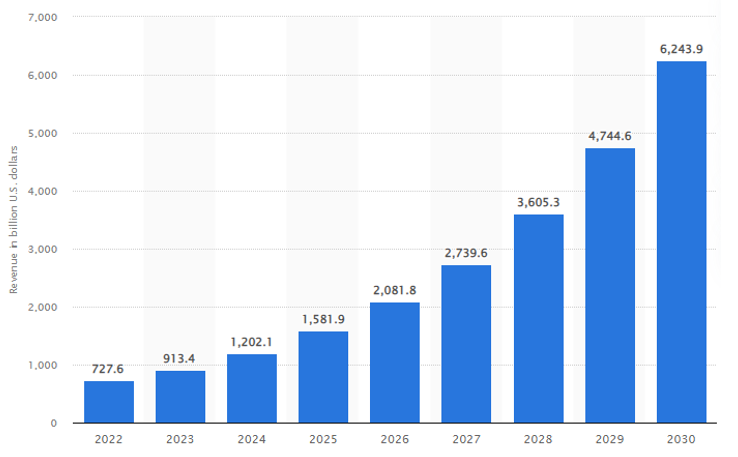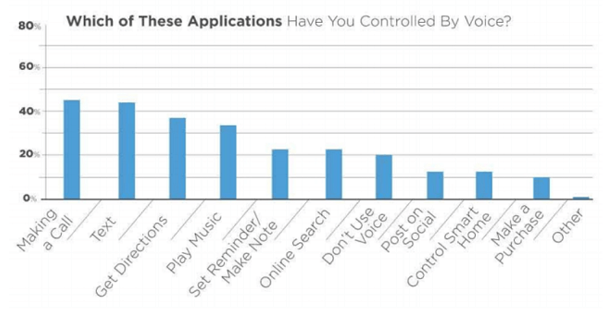Digital marketing forecasts and trends: from personalization to artificial intelligence, the future is digital
Digital marketing is a form of marketing that is based on the use of digital tools and online channels to promote a company, product or service. Thanks to the spread of the Internet, it has become increasingly important for companies with a view to reaching their target and increasing their online visibility.
Digital marketing activities can involve different strategies, including search engine optimization (SEO), online advertising (paid advertising), social media marketing (SMM), email marketing, content marketing, digital analytics and much more. It offers the opportunity to reach a large and diverse audience, to monitor the results of your activities in real time and to adapt your strategies based on the feedback and data collected.
In this way, companies can gain a competitive advantage, build their online image and increase their turnover. For further information, we refer you to our article on what digital marketing is.
Digital marketing is one of the most dynamic sectors of our digital age. It is a constantly changing sector, which adapts to technological changes and the evolution of people’s behavior, with new tools, platforms and strategies. Let’s see what the trends will be for the near future.
The importance of personalizing people’s experiences
Personalization will be a major digital marketing trend in the coming years. With the increasing availability of data about online consumer behavior, more and more companies will be able to offer customers personalized experiences. Personalization may apply to all types of content, and to products, services, offers, messages and advertisements.
Digital marketing personalization includes the use of demographic, geographic, psychographic and behavioral data to create personalized offers that respond to people’s needs and desires, thus reaching more effectively their customers, more likely to a greater fidelity towards the brand, called brand loyalty (hence the famous Aaker pyramid on the 4 levels of brand awareness).
Digital marketing also offers the ability to personalize people’s experience through dynamic content creation, audience segmentation, and marketing automation. Digital marketing personalization helps achieve the primary goal of any marketing strategy: creating a long-term relationship with the customer.
The experience of people at the center, in every touchpoint of the experience
The experiences of people will be increasingly at the center of digital marketing strategies, in conjunction with the fact that with the continuous development of technologies and the growing adoption of the internet and social media, it has become possible to reach an increasingly vast and diversified audiences, offering services and products on a global scale. Companies will have to focus on how to provide valuable, better experiences, that is, which intercept people’s needs and expectations, at every touchpoint of the customer journey, therefore from the search for information to the final purchase.
The experiences and experiences of people are now at the center of consumption dynamics, therefore it becomes essential to choose effective and personalized communication, in a context in which competition is increasingly fierce, and in which people are increasingly attentive to product quality and the services offered.
In this sense, digital marketing represents an essential tool for companies, which can use the information collected on their customers and their consumption habits to create targeted and highly performing advertising campaigns. Thanks to the use of Big Data, artificial intelligence algorithms and machine learning, it becomes possible to identify the wishes and needs of individual customers, to offer them tailor-made services and products.
Artificial intelligence and machine learning to predict market trends
Artificial intelligence and machine learning are changing the landscape of digital marketing by offering companies an important support in improving the user experience and creating personalized and targeted marketing strategies. Thanks to the collection and analysis of data (especially from social media and search engines), companies can gain a greater understanding of customer behaviors in order to anticipate their preferences and thus offer an improved user experience.
Furthermore, through predictive models, AI and ML are able to predict market trends and identify the customer groups most inclined to interact with advertising content. This allows the company to focus on the most important aspects of the campaign, increasing the success of the campaign. Finally, AI and ML can provide important support in managing the company’s reputation by constantly monitoring customer feedback and intervening quickly to resolve any problems.

The power of persuasion of influencer content
Influencers are becoming increasingly important in digital marketing strategies. Their power rests on their ability to connect with people authentically and promote products with a more believable message than traditional forms of advertising. Often belonging to the world of entertainment or sport, but also simple people who have developed a strong presence on social media, influencers are able to influence consumers’ purchasing choices and promote products and services in a very effective way.
Their great ability to reach audiences through social media, combined with their authenticity and their engagement with their followers, makes them an increasingly popular communication channel for companies. Thanks to their credibility and the trust they have built with their fans, influencers can promote products in a very natural and convincing way, favoring the acquisition of new customers, expanding the base of followers and generating a high level of engagement.
Furthermore, influencers can become ideal partners for companies that want to achieve their marketing objectives, thanks to the possibility of collaborating with them and having access to a large audience of potential customers. For example, through partnering with an influencer, a company can gain greater visibility for their product or service, increase the public’s level of trust in their products, or strengthen their brand.
Programmatic advertising, efficient and targeted digital advertising
Programmatic advertising is a form of automated digital advertising in which advertisements are placed in a timely and targeted manner based on user characteristics, such as your geographic location, age, interests and browsing habits.
Programmatic advertising allows companies to advertise their products on a variety of platforms more efficiently; in fact, this form of advertising uses algorithms and advanced technologies to make automated bids on digital advertising space in real time, ensuring that the ads are displayed only to interested potential customers.

The next evolutions in programmatic advertising mainly concern the integration of AI technologies to further improve the effectiveness of the results obtained. AI helps predict users’ purchasing intent and generate personalized solutions, improving the quality of lead generation and conversions.
Another emerging trend is the inclusion of real-time viewed video (RTV) advertising formats, which allow you to reach more viewers and deliver more exciting, engaging, and attention-grabbing advertising content.
Furthermore, greater integration is expected between programmatic advertising and the Internet of Things (IoT), which will make it possible to collect information on user behavior even offline (such as their movements or visits to physical stores), improving the personalization of their advertising experience.
A correlation is also emerging between programmatic advertising and programmatic DOOH (Digital Out of Home, is a technology that uses digital screens outside the home environment, such as in subway stations, shops, malls and airports. Thanks to the programmatic DOOH, it is possible to reach a wider and more diversified audience than with other forms of digital advertising), a synergy that lies in the latter’s ability to use the same technologies and algorithms as programmatic advertising to make advertising more targeted and personalized. In this way, programmatic DOOH can offer greater advertising efficiency and a better user experience for users.
The use of cross-device solutions is also expected to increase, whereby advertisers can monitor and track user experience across different devices, such as smartphones, tablets, laptops and smart TVs. In this way, it will be possible to improve the accuracy and effectiveness of advertising targeting, reaching consumers at every stage of their purchase journey.
A problem for marketers will be the progressive abandonment of third-party cookies, welcomed with great concern by the whole sector for its impact on the online advertising landscape: it can actually represent an opportunity, i.e. it will be possible to combine reach and omnichannel even in cookieless environments.
Augmented and virtual reality revolutionize marketing and the shopping experience
Augmented reality is a technology that allows you to superimpose virtual objects on the real world. Leveraging augmented reality can help companies provide their customers with an immersive, interactive and engaging experience for people.
Augmented reality can essentially be used as a marketing tool to engage and retain consumers. For example, a company can use augmented reality to create an interactive advertising campaign, where users are invited to scan a QR code, a barcode, or an image to access exclusive content or special offers. In this way, augmented reality can be used to increase brand awareness and generate leads.
Furthermore, augmented reality can be used to enhance the online shopping experience. A common example is its use to virtually try on a product before buying, such as jewelry or clothing. In this way, augmented reality can help consumers make better purchasing decisions and increase conversions.
Finally, augmented reality can be used to create a memorable customer experience, improving user engagement with the brand and generating value for the consumer. For example, a company can deliver an in-store augmented reality experience, where people can interact with virtual products, get additional information, participate in games or activities, get discounts. In this way, augmented reality can help companies create stronger and more lasting relationships with their customers.
Virtual Reality (VR) is becoming increasingly popular as a digital marketing tool, as it offers a unique way to engage audiences, leading customers to experience your products or services in a much more direct and immersive way than traditional digital marketing techniques.
For example, a tourism company can use VR to show their customers the tourist destinations to visit, giving them the opportunity to more realistically explore local landscapes and cultures.
VR can also influence the shopping experience by collecting data about customers and their behavior. For example, through the use of special VR devices, companies can collect information on customers’ attention to products or their reaction times, useful data for improving the shopping experience and personalizing the offer.
Videos are revolutionizing corporate communication
Booming as a reference medium on the internet, videos offer businesses an effective way to achieve their marketing objectives, including engagement, brand awareness and lead generation, due to the fact that they are highly attention-grabbing of the public.
Video marketing can be used for multiple purposes, including:
- Promote a product or service: promotional videos can be used to raise awareness of your product or service and tell about its benefits.
- Educate the public: tutorial or instructional videos can be used to educate the public on a certain topic.
- Building a brand: videos can be used to create a strong brand identity and build a relationship with the audience.
- Retain customers: Videos can be used to keep customers loyal to your brand and improve the consumer experience.
Videos can be used across a variety of platforms including websites, social media, blogs, streaming platforms, email marketing and so much more; moreover, they can be produced in various formats, including promotional films, interviews, video testimonials and much more.
Video marketing will evolve by integrating augmented and virtual reality, personalizing content according to consumer tastes and moving to online platforms such as YouTube, Instagram, TikTok and Netflix, while traditional television will become less and less relevant. Video marketing will increasingly use artificial intelligence to create video content automatically, generate analysis on the data collected and improve the effectiveness of advertising campaigns.
Some recent statistics on video marketing, provided by Demandsage.com:
- 1 billion people view video on the internet daily.
- 86% of marketers use video as a marketing tool.
- 73% of marketers use live streaming video.
- 54% of businesses use video on their landing pages.
- Product demos are the main type of B2B video advertising of companies.
- The influencer marketing market is worth US$13.8 billion
- A brand or business that people support should provide more video content, according to 54% of consumers.
- 64% of customers globally make purchases after watching the brand’s social videos.
- 92% of marketers now say video is a very important part of their marketing strategy as of 2023.
- A favorable ROI was recorded by 92% of video marketers.
- 86% of video marketers say video is successful in generating leads.
Chatbot, personalized customer service in real time
Chatbots allow businesses to provide customers with personalized, real-time customer service through messaging platforms such as Facebook Messenger and Telegram. The relationship between chatbots and digital marketing is very strong as chatbots are a very powerful tool to improve the effectiveness of digital marketing strategies. In fact, chatbots allow you to create an immediate and personalized user experience, which can increase audience engagement and leads.
Furthermore, chatbots are able to handle tasks such as automating the response to user messages, sending personalized promotional messages and collecting data to analyze audience behaviors.
However, to be successful, chatbots need to be strategically implemented, integrated with other digital marketing tools, and managed to ensure a high-quality, authentic conversation experience.
The future of chatbots will be characterized by ever greater humanization, specialization on specific fields of interest, support for different languages and new features such as appointment booking and payment, supported by greater resources such as access to specialized databases to provide even more answers accurate and detailed to users
Social media marketing: listening to people’s experiences on social media
People’s experiences can become the fulcrum of digital marketing strategies also in terms of content and interactions on social media. In fact, companies can use this media channel to create an empathic relationship with their customers, trying to understand their fears, their desires, their history and their aspirations.
To do this, it becomes essential to put into practice authentic and transparent communication, which knows how to arouse the public’s interest without falling into the trap of useless promises or false moralism. Only in this way will companies be able to build a solid base of loyal customers, who appreciate their products and services for their authenticity and for the care with which they are offered.
Businesses will increasingly use social media to engage with their customers, increase brand awareness and generate leads.
In the future, social media marketing will increasingly focus on social video channels, such as YouTube, Instagram and TikTok. Furthermore, artificial intelligence and machine learning will be used to create and deliver personalized content and to improve the user experience on social media.
There will also be increased efforts to engage influencers on social media, as they have become an important lever in reaching new audiences and building trust in brands. Additionally, brands will increasingly focus on building communities on social media, seeking to create a sense of belonging and engagement among their customers.
Finally, it will be increasingly important for brands to maintain transparency and accountability of their social media content, in response to growing concerns about user privacy and data security.
Some numbers on the use of social media:

Social Commerce, the future of online shopping: personalized experiences and viral marketing
With the introduction of shopping features on social networks such as Instagram, Facebook and Pinterest, social platforms will become increasingly central to online shopping. Social commerce uses social platforms to develop customer relationships, create personalized shopping experiences, promote brand trust, and create viral marketing efforts by engaging people.
On social platforms, users can basically view the products, read reviews and comments, interact with other users, and finally make the purchase directly through the platform, with the opportunity to then share this experience. Social commerce has this peculiarity of involving not only the purchase phase, but also the one preceding and following the purchase (the latter phases mentioned which can also be included in the subset of social shopping).
This sharing of opinions and experiences on the part of customers is useful for companies, which through careful monitoring of social shopping can better direct their efforts in making their products/services truly efficient and customer engagement more quality.
Revenue from Social Commerce, worldwide, from 2022 to 2030 (in billions of US dollars):

Source: Statista
The importance of SEO optimization for the visibility of online companies
Optimizing for organic (i.e. non-sponsored) search engine appearance will become increasingly important in marketing strategies. SEO (acronym for Search Engine Optimization) allows companies to place their content at the top of search results, thus increasing the visibility of their products and services, and improving their online brand reputation.
SEO focuses on how to improve your website or content ranking in search engines, such as Google, through content and keyword optimization. When a website is ranked higher in search results, it is easier for potential customers to find it and access its products or services.
SEO is an ongoing process and requires constant updating and attention to stay abreast of search engine algorithms and market trends. For this reason it is essential for a company to constantly rely on expert SEO professionals, able to increase and maintain high: the organic traffic of the website; positioning on search engines; authority and online visibility.

The near future sees an increase in voice search for SEO, given the increased diffusion of voice assistants such as Amazon’s Alexa. This requires new content optimization strategies to answer users’ vocal questions in a natural and conversational way. Also, artificial intelligence and machine learning are becoming increasingly important in SEO. Google uses AI to improve its understanding of content and provide more relevant search results to users.
Another trend is the importance of the user experience on the website in terms of loading speed, core web vitals (set of parameters that are related to the speed, stability and response time of a website layout) and easy navigation, as they are factors that can influence the site’s positioning in search results.
Finally, an increased use of video and visual content is expected to enhance the impact of online content and attract users’ attention.
Some recent statistics on SEO, provided by Techjury.net:
- 68% of online experiences start with a search engine.
- Second page results get clicks for 0.63% of Google searches.
- Google holds 91.07% of search engine traffic while Bing accounts for 3% and Yahoo 2.87%.
- Organic search generates 53.3% of all website visitors.
- 69% of digital traffic comes from local and organic searches.
- 86% of marketers say video has helped them increase traffic.
- 27% of mobile users prefer voice search or a search engine app.
- 64% of marketers see an increase in SEO effectiveness.
- Search engines generate 300% more traffic to content sites than social media.
- 21% of users access more than one search result.
Future SEO trends will be influenced by the continuous evolution of technology and online user behaviors, but the goal will always remain to provide relevant and useful content to meet users’ needs.
Voice search, now complementary to text search
Voice search, a human-machine interaction technology that allows users to search for information using their voice, is becoming increasingly popular, especially among young people, in particular thanks to the spread of voice assistants such as Google Assistant, Apple’s Siri and Alexa by Amazon. According to data from Think with Google, 27% of the global online population uses voice search on their mobile devices; voice search currently ranks sixth among voice-controlled activities on devices (second place if we think purely of mobile), according to data provided by Search Engine Land.

Source: Search Engine Land
According to a survey by PWC, 57% of respondents said they communicated/spoke/given voice commands on their smartphone, compared to only 29% on tablets, laptops and desktops.

Source: PWC
Companies will therefore have to adapt their content to make the most of the keywords and key phrases of voice search, which in formulating queries is different from manual search.
Voice search has important implications for digital marketing. In fact, although it is less precise than text search, voice search is particularly useful in finding local information, such as the location of a store or restaurant, and in conversational searches.
SEO experts are developing new strategies to optimize content for voice search. For example, using specific keywords and creating content that can answer specific questions that users can ask through their voice.
Furthermore, voice search is leading to the creation of more personalized marketing experiences, thanks to the ability of voice assistants to identify the user’s voice and offer relevant and personalized answers, a bit like the use of cookies.
In the future, we could see an increase in the use of in-car voice assistants or wearable devices that we can access through voice.
Conclusions
The ever-increasing diffusion of digital devices and the growing presence of online companies have inevitably led to continuous technological evolution and the emergence of new trends in the field of digital marketing; especially in the next 5 years strong changes are expected, companies will have to be ready to implement them, to make the most of the opportunities that will emerge and remain competitive.
An exciting future awaits us.